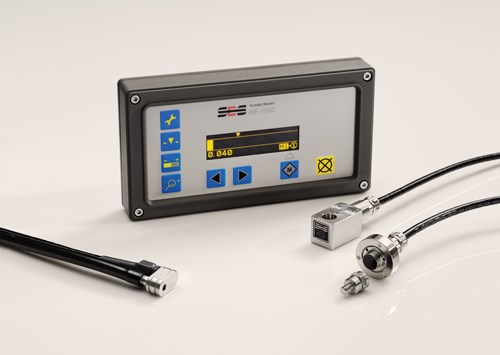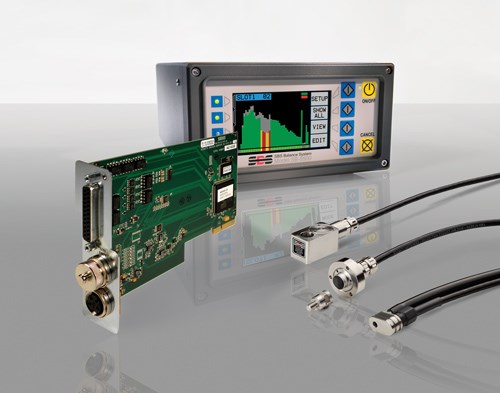Acoustic Emission Sensing Improves Productivity and Prolongs Grinding Wheel Life
In production of precision metal parts such as automotive or aerospace components, grinding to precise tolerances is of utmost importance.
In production of precision metal parts such as automotive or aerospace components, grinding to precise tolerances is of utmost importance. To maintain a high degree of precision throughout a production run, grinding wheel dressing is a necessary operation to ensure that the wheel retains the optimal shape. But grinding wheels, particularly the superabrasive ones, can be very expensive, and dressing too much can be wasteful and impact productivity. Also, manual dressing operations may fail to identify emerging structural problems with the wheel. Ideally, a wheel should be dressed only when its shape falls out of spec, and no more material should be removed from the wheel than is absolutely necessary to restore it to its desired shape.
The same need for precision often applies to positioning the grinding wheel against the workpiece. If this operation is not done carefully, too much material could be removed from the production unit, or the wheel itself could be damaged. On the other hand, if the grinding wheel is moved very slowly to avoid this problem, time can be wasted, and the productivity of the machine will be less than optimal.
While grinding machine builders agree about the need for precision and maximum productivity, some people may argue that technology for optimizing the dressing and wheel positioning operations needs further improvement. One of the issues that makes monitoring the profile of a grinding wheel during the dressing operation difficult is that the operation typically takes place beneath a high volume stream of cooling fluid (Figure 1). Hence, visual techniques for observing the wheel profile are ineffective. In the absence of an easy way to monitor wheel shape, many machine operators run extra dressing cycles (beyond the dressing cycle that would typically do the job) to make sure the desired shape is attained.
Sensing Technology
For Schmitt Industries of Portland, Oregon, the solution to these problems comes through creative application of a sensing technology that was initially developed for dry grinding applications: acoustic emission (AE) sensing. AE sensing relies on the fact that when a grinding wheel touches a workpiece or a dressing wheel, even the slightest contact produces a sound that can be detected by sensitive instrumentation.
Traditionally, AE sensors have relied on vibration transmitted through the frame of the grinding machine, but it turns out that the coolant flow itself can be used to transmit the sound of the grinding wheel and workpiece (or dressing wheel) coming together. In operation, acoustic signals coming from the workpiece travel up the coolant stream to the sensor module, which is otherwise isolated from its mounting attachment to the machine via rubber O-rings that surround it. As long as the coolant stream is uninterrupted, the sensors can pick up even the slightest noise from contact with the grinding wheel. Acoustic emission technology can be so sensitive that it takes only a small number of grains of the wheels coming together to register a touch. By incorporating AE sensors that are supported by automated controls, a CNC machine can automatically perform functions such as grind detection, crash protection, gap elimination and dressing control.
Implementation
One example of a high precision AE product that is available to machine builders and job shops is Schmitt Industries’ SBS AEMS (Acoustical Emission Monitoring System, Figure 2). Schmitt’s AE-1000 acoustic monitor is a basic control unit that offers crash protection and one programmable process limit that can be used for gap elimination or for monitoring grind quality. The AE-1000 supports multiple inputs to provide separate gap and crash limits for one machine, or gap or crash detection for multiple grinding machines simultaneously.
More advanced AE functionality is supported by Schmitt’s ExactDress (Figure 3). This hardware/software product works with the company’s SB-5500 grinding control platform to automate the dressing process by looking at the live acoustic emission signature of the dressing operation and comparing it with the profile of a known successful wheel dress. When there is a match, the system knows that the wheel is dressed correctly. Matching with an existing profile avoids the guesswork and over-dressing that typically result from manually implemented dressing cycles, improving quality while saving both time and cost. With ExactDress, users don’t need to replace expensive CBN or diamond grinding wheels as often as they have in the past.
To set up the controls, the system is “trained” with the overall gain, measurement scale and measurement window parameters for the machine, and the crash and gap sensitivity parameters are set for the particular wheel to be dressed. Then, a successful dressing cycle is performed and the acoustic signature is recorded. Once the reference data set is completed and stored as a known good dress, the data can be used to evaluate subsequent dresses of the same process.
— Accretech SBS
Related Content
Emag Grinding Solutions Provide Precise Gear-Profile Grinding
The G 160 and G 250 gear-profile grinding machines provide short chip-to-chip times, intelligent axis concepts as well as thermal and mechanical stability.
Read MoreGrinding Options for Dental Burrs and Rotary Instruments
Equipment to grind dental burrs continues to evolve. Here are five options for grinding these types of workpieces.
Read MoreCarbon Fiber Spindles Aim to Eliminate Grinding Variance
These spindles available on Tschudin CNC centerless grinders are designed to minimize the heat transfer factor while optimizing dimensional stability and material removal rate.
Read MoreGrindstar Replaces Turning With Efficient Grinding
PMTS 2023: The Grindstar machine uses a method that enables the entire workpiece contour to be ground in a single processing operation.
Read MoreRead Next
Thread Grinding with ‘A’ Axis
With several factors propelling a surge in demand for parts with technically complex external and internal threads with large pitches, the need for better accuracy and efficiency has created challenges.
Read MoreSeeing Automated Workpiece Measurement in Real Time
User-friendly inspection software for CNC machining centers was shown at IMTS 2024 monitoring measurements between and after machining while performing SPC based on recorded measurement values.
Read More5 Aspects of PMTS I Appreciate
The three-day edition of the 2025 Precision Machining Technology Show kicks off at the start of April. I’ll be there, and here are some reasons why.
Read More
























